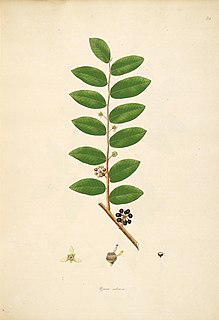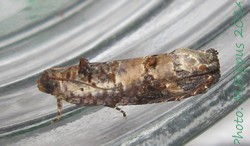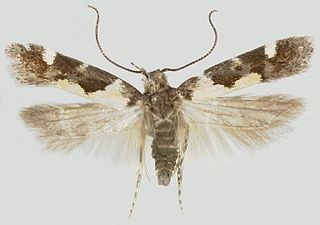
The peanut, also known as the groundnut, goober (US), pindar (US) or monkey nut (UK), and taxonomically classified as Arachis hypogaea, is a legume crop grown mainly for its edible seeds. It is widely grown in the tropics and subtropics, being important to both small and large commercial producers. It is classified as both a grain legume and, due to its high oil content, an oil crop. World annual production of shelled peanuts was 44 million tonnes in 2016, led by China with 38% of the world total. Atypically among legume crop plants, peanut pods develop underground (geocarpy) rather than above ground. With this characteristic in mind, the botanist Carl Linnaeus named the species hypogaea, which means "under the earth".

Psoralea is a genus in the legume family (Fabaceae). It includes the subgenus Psoralea subg. Pediomelum (Rydb.) Ockendon, also treated as genus Pediomelum. Although most species are poisonous, the starchy roots of P. esculenta and P. hypogaea are edible. A few species form tumbleweeds.
Arachis villosulicarpa is a perennial peanut species, which is cultivated by indigenous people in Mato Grosso, a state of Brazil. Its wild progenitor is thought to be Arachis pietrarellii. Although it is related to the common peanut, Arachis hypogaea, it was separately domesticated: A. villosulicarpa is diploid, whereas A. hypogaea is tetraploid.

Polyalthia malabarica is a species of plant in the family Annonaceae and tribe Miliuseae. It is endemic to south-west India. It is threatened by habitat loss.
Polyalthia angustissima is a species of plant in the Annonaceae family. It is a tree found in Malaysia, Singapore, and possibly Vietnam.

Polyalthia is a genus of flowering plants in the family Annonaceae. There are approximately 90 species distributed from Africa to Asia and the Pacific.
Polyalthia hookeriana is a species of plant in the family Annonaceae. It is a tree found in Malaysia and Singapore.
Polyalthia lancilimba is a species of plant in the Annonaceae family. It is endemic to China.
Phaeanthus ophthalmicus is a species of plant in the family Annonaceae and tribe Miliuseae. It is a tree found in Peninsular Malaysia and Singapore.
Polyalthia pachyphylla is a species of plant in the family Annonaceae. It is a tree endemic to Peninsular Malaysia.
Polyalthia palawanensis is a species of plant in the Annonaceae family. It is endemic to the Philippines.
Disepalum plagioneurum is a species of plant in the Annonaceae family. It is found in China and northern Viet Nam.
Polyalthia rufescens is a species of plant in the Annonaceae family. It is native to Kerala and Tamil Nadu in India. It is threatened by habitat loss.
Polyalthia shendurunii is a species of plant in the Annonaceae family. It is endemic to Kerala in India.
Polyalthia verrucipes is a species of plant in the Annonaceae family. It is endemic to China.

Dudua aprobola, the mango flower webworm or litchi leaf roller, is a moth of the family Tortricidae. The species was first described by Edward Meyrick in 1886. It is a pest on several economically important crops.

Stegasta bosqueella is a species of moth of the family Gelechiidae. It is found in North America, including Alabama, Florida, Georgia, Illinois, Iowa, North Carolina, Oklahoma, South Carolina, Texas and Virginia.
Meiogyne laddiana is a species of plant in the genus Polyalthia. It is endemic to Fiji.

Huberantha cerasoides is a species of trees in the family Annonaceae and tribe Miliuseae. It is the type species of the relatively new genus Huberantha.

Copiapoa hypogaea, the underground copiapoa, is a species of flowering plant in the genus Copiapoa in the cactus family (Cactaceae), native to northern Chile. It has gained the Royal Horticultural Society's Award of Garden Merit.








